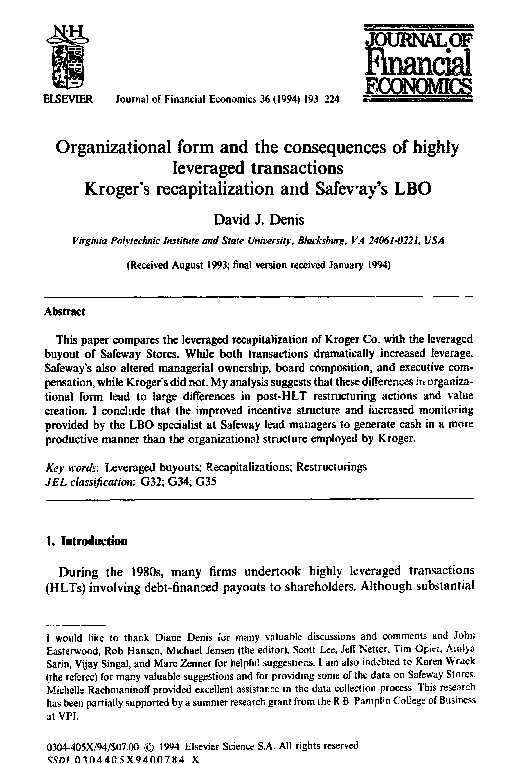What is a Highly Leveraged Transaction?
Highly leveraged transactions are often undertaken by companies looking to expand their operations or make strategic acquisitions. By using borrowed funds, companies can increase their purchasing power and take advantage of investment opportunities that may not be possible with their own capital alone.
Key Features of Highly Leveraged Transactions

There are several key features that distinguish highly leveraged transactions:
- High Debt Levels: In HLTs, the debt levels are significantly higher than the equity invested. This allows companies to amplify their potential returns, but also exposes them to higher risks.
- Increased Financial Risk: The high debt levels in HLTs increase the financial risk for the companies involved. If the investment or acquisition does not generate sufficient returns to cover the debt obligations, the company may face financial distress or even bankruptcy.
- Debt Financing: HLTs rely heavily on debt financing, often through bank loans or bond issuances. The borrowed funds are used to finance the investment or acquisition, with the expectation that the returns generated will be sufficient to repay the debt.
- Potential for Higher Returns: Despite the increased risk, highly leveraged transactions have the potential to generate higher returns compared to investments made solely with equity. This is because the borrowed funds allow companies to invest in larger and potentially more profitable opportunities.
- Regulatory Scrutiny: Highly leveraged transactions often attract regulatory scrutiny due to their potential impact on the stability of the financial system. Regulators may impose restrictions or require additional oversight to mitigate the risks associated with these transactions.
Overall, highly leveraged transactions can be a double-edged sword. While they offer the potential for higher returns and growth opportunities, they also come with increased financial risks. It is important for companies and investors to carefully assess the risks and rewards before engaging in highly leveraged transactions.
The Mechanics of Highly Leveraged Transactions

Highly Leveraged Transactions (HLT) involve a complex set of mechanics that allow companies to acquire other businesses or assets using a significant amount of borrowed money. These transactions typically involve a high level of debt, which is used to finance the acquisition.
One of the key mechanics of HLT is the use of leverage, which refers to the use of borrowed funds to finance an investment. In the case of HLT, the acquiring company borrows a large amount of money from banks or other financial institutions to fund the acquisition. This allows the acquiring company to use a relatively small amount of its own capital and maximize the potential return on investment.
Another important mechanic of HLT is the creation of a special purpose vehicle (SPV). An SPV is a separate legal entity that is created solely for the purpose of acquiring the target company or asset. The SPV is typically funded by the borrowed money and is used to hold the acquired assets. By using an SPV, the acquiring company can isolate the risks associated with the acquisition and protect its own balance sheet.
Once the acquisition is completed, the acquired assets are used as collateral for the borrowed money. This means that if the acquiring company fails to repay the debt, the lenders have the right to seize the acquired assets and sell them to recover their money. This creates a significant level of risk for the acquiring company, as it needs to generate enough cash flow to repay the debt and avoid default.
Furthermore, HLT often involves the restructuring of the target company’s existing debt. This can include refinancing existing debt at more favorable terms or even writing off a portion of the debt. The goal of debt restructuring is to improve the financial position of the target company and make it more attractive to potential buyers.
Benefits and Risks of Highly Leveraged Transactions
Highly Leveraged Transactions (HLT) can offer both benefits and risks to the parties involved. It is important to understand these potential outcomes before engaging in such transactions.
Benefits:
1. Increased financial flexibility: HLT allows companies to access a large amount of capital quickly, which can be used for various purposes such as expansion, acquisitions, or debt repayment. This increased financial flexibility can help companies seize growth opportunities and improve their overall financial position.
2. Potential for higher returns: By leveraging their investments, companies have the potential to generate higher returns on their capital. This can be particularly beneficial in industries with high growth potential or during periods of economic expansion.
3. Enhanced shareholder value: Successful HLTs can lead to increased shareholder value through improved financial performance and profitability. This can attract more investors and potentially increase the company’s stock price.
Risks:
1. Increased financial risk: HLTs involve taking on a significant amount of debt, which can increase the financial risk for companies. If the company is unable to generate sufficient cash flow to meet its debt obligations, it may face financial distress or even bankruptcy.
2. Limited flexibility: Highly leveraged companies may have limited flexibility in terms of financial decision-making. They may be constrained by debt covenants or have limited access to additional financing options, which can hinder their ability to respond to changing market conditions.
3. Market volatility: HLTs can be particularly risky during periods of market volatility. Changes in interest rates, economic conditions, or industry dynamics can have a significant impact on the company’s ability to meet its debt obligations and generate expected returns.
4. Negative impact on credit rating: Highly leveraged companies may face downgrades in their credit ratings, which can increase borrowing costs and limit their access to capital in the future. This can further exacerbate financial difficulties and hinder growth prospects.
5. Potential for conflicts of interest: HLTs often involve multiple parties, such as lenders, investors, and management teams. Conflicts of interest can arise if the parties have different objectives or priorities, which can complicate decision-making and potentially lead to disputes.
It is important for companies considering highly leveraged transactions to carefully assess the potential benefits and risks involved. They should conduct thorough due diligence, seek professional advice, and develop a comprehensive risk management strategy to mitigate potential pitfalls and maximize the chances of a successful outcome.

Emily Bibb simplifies finance through bestselling books and articles, bridging complex concepts for everyday understanding. Engaging audiences via social media, she shares insights for financial success. Active in seminars and philanthropy, Bibb aims to create a more financially informed society, driven by her passion for empowering others.
